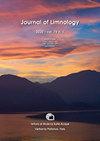肥厚鱼塘级联中的浮游植物-浮游动物耦合
IF 1.1
4区 环境科学与生态学
Q4 LIMNOLOGY
引用次数: 0
摘要
在中欧,人工鱼塘代表了相当大比例的浅湖生态系统,其中浮游植物和浮游动物是食物网的重要组成部分。由于鱼类资源丰富和集约化渔业管理,大多数鱼塘现在是富营养化或肥厚化的,这对浮游生物的组合产生了明显的影响。为了更好地了解鱼塘中浮游植物-浮游动物的耦合,本研究在随后的两年里对三个小鱼塘的级联生态关系进行了研究。共记录浮游植物类群133个,以绿藻、硅藻和裸藻类为主;浮游动物类群60个。多因素分析显示,溶解氧含量、溶解无机氮和生化需氧量是影响浮游植物生物量的主要因素,而影响浮游动物组成的最显著环境变量是溶解氧、磷酸盐浓度和电导率。共对应分析表明,浮游植物与浮游动物的密度之间存在显著的相关关系,在前4个轴上的互相关为76% ~ 87%。如此高的相互关系表明浮游植物和浮游动物之间有很强的关系,甚至在决定鱼塘生态系统的肥厚条件下也是如此。本文章由计算机程序翻译,如有差异,请以英文原文为准。
Phytoplankton-zooplankton coupling in a cascade of hypertrophic fishponds
In Central Europe, a significant proportion of shallow lake ecosystems are represented by artificial fishponds, where phytoplankton and zooplankton are an essential part of the food web. Owing to their high fish stocks and intensive fishery management, most fishponds are now eutrophic or hypertrophic, which has had clear impacts on plankton assemblages. To obtain a better understanding of phytoplankton-zooplankton coupling in fishponds, this study examines their ecological relationships in a cascade of three small fishponds over two subsequent years. In all, 133 phytoplankton taxa were recorded, mostly chlorophytes, diatoms and euglenophytes, and 60 zooplankton taxa. Multivariate analysis revealed dissolved oxygen content, dissolved inorganic nitrogen and biochemical oxygen demand as the main factors influencing phytoplankton biomass, while the most significant environment variables affecting zooplankton composition were dissolved oxygen, phosphate concentrations and conductivity. Co-correspondence analysis revealed a significant relationship between phytoplankton and zooplankton density, with cross-correlations from 76% to 87% within the first four axes. Such a high cross-correlation denotes a strong relationship between phytoplankton and zooplankton, even within the hypertrophic conditions determining fishpond ecosystems.
求助全文
通过发布文献求助,成功后即可免费获取论文全文。
去求助
来源期刊

Journal of Limnology
地学-湖沼学
CiteScore
2.70
自引率
6.20%
发文量
12
审稿时长
3 months
期刊介绍:
The Journal of Limnology publishes peer-reviewed original papers, review papers and notes about all aspects of limnology. The scope of the Journal of Limnology comprises the ecology, biology, microbiology, physics, and chemistry of freshwaters, including the impact of human activities, management and conservation. Coverage includes molecular-, organism-, community-, and ecosystem-level studies on both applied and theoretical issues. Proceedings of workshops, specialized symposia, conferences, may also be accepted for publication.
 求助内容:
求助内容: 应助结果提醒方式:
应助结果提醒方式:


